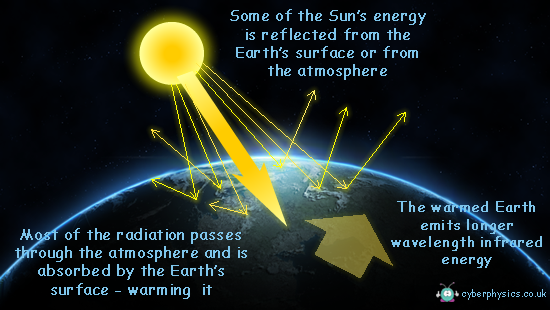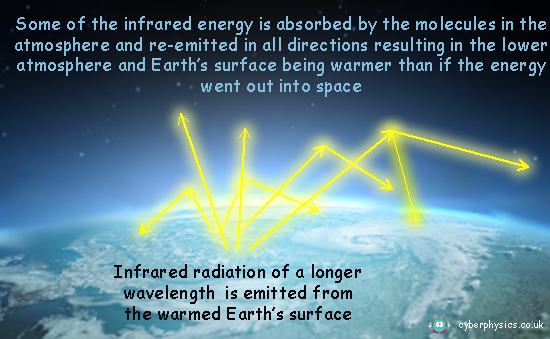The Greenhouse Effect - a cause of Global Warming

Electromagnetic infrared energy from the sun is absorbed by our atmosphere and the Earth's surface. This energy
drives the Earth's weather and climate systems (see wind and wave power),
and warms the Earth's surface.
The Earth radiates some of that energy
back out into space. But when it returns the energy into space as infra red radiation, it is of a longer wavelength. The hotter the body radiating infrared, the shorter the wavelength of the IR radiation. The Sun is very hot therefore the IR radiation we recieve is of a very short wavelength. Once warmed the Earth re-radiates some of the energy, but at a longer wavelength.
The major greenhouses gases
Greenhouse
gases, such as:
 water vapour (H2O)
water vapour (H2O)
 carbon dioxide (CO2)
carbon dioxide (CO2)
 methane or natural gas (CH4)
methane or natural gas (CH4)
 nitrous oxide (N2O)
nitrous oxide (N2O)
 hydrofluorocarbons (HFCs) and perfluorocarbons (PFCs)
hydrofluorocarbons (HFCs) and perfluorocarbons (PFCs)
are particularly good at 'trapping' infrared energy of longer wavelengths, retaining
heat energy within our atmosphere somewhat like the glass panels of a greenhouse.
Without this natural "greenhouse effect," temperatures would be much lower than they
are now as the Earth would radiate much more of the heat energy it got
from the Sun straight back out into space! Life as we know it would not
be possible. Instead, thanks to greenhouse gases, the earth's average
temperature is a more hospitable 16°C.
However, problems may arise
if the atmospheric concentration of greenhouse gases increases.
What will happen if Greenhouse Gases in our atmosphere increase?
It is expected that
the average global surface temperature could rise 0.6-2.5°C in the
next fifty years, and 1.4-5.8°C in the next century, with significant
regional variation. That doesn't sound much but it is quite significant.
The average global temperature during the last ice age was only 5oC
lower than today!
 Evaporation will
increase as the climate warms (adding to the problem because water vapour
is a greenhouse gas), which will increase average global rainfall.
Evaporation will
increase as the climate warms (adding to the problem because water vapour
is a greenhouse gas), which will increase average global rainfall.
 Soil moisture is
likely to decline in many regions leading to crop failures and famines,
and intense rainstorms are likely to become more frequent - leading
to storm damage of buildings and crops.
Soil moisture is
likely to decline in many regions leading to crop failures and famines,
and intense rainstorms are likely to become more frequent - leading
to storm damage of buildings and crops.
 Sea level is also
likely to rise and low lying regions will flood. This will be because
the oceans will expand (as they are at a higher temperature) and also
some of the ice and snow on land will melt (the ice in the sea melting will not affect the sea level...).
Sea level is also
likely to rise and low lying regions will flood. This will be because
the oceans will expand (as they are at a higher temperature) and also
some of the ice and snow on land will melt (the ice in the sea melting will not affect the sea level...).
As the climate changes,
most species of plants and animals will not be able to survive in their
current geographic locations. They will need to move to more suitable
areas. However, whereas they had 10,000 years to adapt to a warming climate
after the last ice age, they will have only 100 years if humans increase
the temperature a similar amount in the next century – around 5 degrees
- and that means many of them will become extinct. Scientists believe
that global warming will not only bring higher temperatures, but also
extreme weather variation. For example, what was once a 100-year flood
might become commonplace and natural disasters such as hurricanes, tornadoes,
blizzards, floods, and droughts will occur more frequently.
Albedo and melting ocean ice
Albedo is the fraction of solar energy (shortwave radiation) reflected from the Earth back into space. It is a measure of the reflectivity of the earth's surface.
Ice, especially with snow on top of it, has a high albedo. That means that most sunlight hitting the surface reflects back out into space. Water is much less reflective - it has a lower albedo. So, if there is a lot of open water in the polar region, more solar radiation will be absorbed by the ocean than when ice dominated. That will speed up global warming.
 Teachers: click here to download a printable worksheet based on this page.
Teachers: click here to download a printable worksheet based on this page.
 to go to a page explaining where the Greenhouse Gases come from.
to go to a page explaining where the Greenhouse Gases come from.
 to go to a page on 'Carbon Storage' a way to counter the increased Greenhouse gases in our atmosphere
to go to a page on 'Carbon Storage' a way to counter the increased Greenhouse gases in our atmosphere
 to see 'News Reports' on global warming
to see 'News Reports' on global warming
Further reading: http://beacon.berkeley.edu/GHGs.aspx
http://bakken.com/guide-energy-emissions-greenhouse-gases-bakken-com/





 Teachers:
Teachers: 


